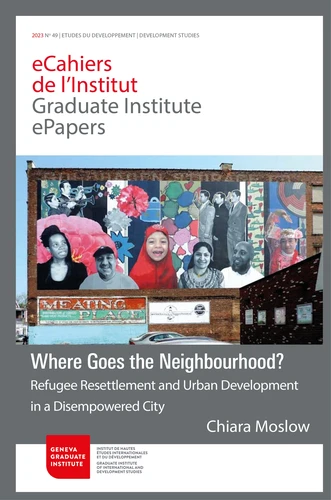Where Goes the Neighbourhood?. Refugee Resettlement and Urban Development in a Disempowered City
Par :Formats :
Disponible dans votre compte client Decitre ou Furet du Nord dès validation de votre commande. Le format Multi-format est :
- Pour les liseuses autres que Vivlio, vous devez utiliser le logiciel Adobe Digital Edition. Non compatible avec la lecture sur les liseuses Kindle, Remarkable et Sony
 , qui est-ce ?
, qui est-ce ?Notre partenaire de plateforme de lecture numérique où vous retrouverez l'ensemble de vos ebooks gratuitement
Pour en savoir plus sur nos ebooks, consultez notre aide en ligne ici
- FormatMulti-format
- ISBN978-2-940600-44-1
- EAN9782940600441
- Date de parution22/05/2023
- Protection num.NC
- Infos supplémentairesMulti-format incluant PDF avec W...
- ÉditeurGraduate Institute Publications
Résumé
This paper explores the intersection of urban restructuring and refugee resettlement. Centring around a case study of Buffalo, New York (NY), USA, it adds to the small but growing number of studies on resettlement in post-industrial contexts. Buffalo is experiencing economic and population growth, termed by some as the city's renaissance (even the refugee renaissance), while others regard it as gentrification and exclusionary development.
At the same time, the city has become one of the largest resettlement sites in the country. In politicians' statements and the media, refugees are credited with being one of the key drivers for this development in the city. Through interviews with various stakeholders, I explore how these phenomena are understood. I argue that this convening of factors creates a particular conception of the figure of the resettled refugee.
In Buffalo, refugees emerge as a particularly valued form of other, capable of driving development in a way that fits ideally within the narrative of 'rust to reinvention'. As such, they become outside economic development agents, divorced from the challenges faced by struggling residents for decades. Resettlement actors navigate this conversation, recognising the challenges faced by refugees and other residents, while at the same time carrying forward prevailing narratives and frames.
We extend our heartfelt thanks to the Vahabzadeh Foundation for financially supporting the publication of best works by young researchers of the Graduate Institute, giving a priority to those who have been awarded academic prizes for their master's dissertations.
At the same time, the city has become one of the largest resettlement sites in the country. In politicians' statements and the media, refugees are credited with being one of the key drivers for this development in the city. Through interviews with various stakeholders, I explore how these phenomena are understood. I argue that this convening of factors creates a particular conception of the figure of the resettled refugee.
In Buffalo, refugees emerge as a particularly valued form of other, capable of driving development in a way that fits ideally within the narrative of 'rust to reinvention'. As such, they become outside economic development agents, divorced from the challenges faced by struggling residents for decades. Resettlement actors navigate this conversation, recognising the challenges faced by refugees and other residents, while at the same time carrying forward prevailing narratives and frames.
We extend our heartfelt thanks to the Vahabzadeh Foundation for financially supporting the publication of best works by young researchers of the Graduate Institute, giving a priority to those who have been awarded academic prizes for their master's dissertations.
This paper explores the intersection of urban restructuring and refugee resettlement. Centring around a case study of Buffalo, New York (NY), USA, it adds to the small but growing number of studies on resettlement in post-industrial contexts. Buffalo is experiencing economic and population growth, termed by some as the city's renaissance (even the refugee renaissance), while others regard it as gentrification and exclusionary development.
At the same time, the city has become one of the largest resettlement sites in the country. In politicians' statements and the media, refugees are credited with being one of the key drivers for this development in the city. Through interviews with various stakeholders, I explore how these phenomena are understood. I argue that this convening of factors creates a particular conception of the figure of the resettled refugee.
In Buffalo, refugees emerge as a particularly valued form of other, capable of driving development in a way that fits ideally within the narrative of 'rust to reinvention'. As such, they become outside economic development agents, divorced from the challenges faced by struggling residents for decades. Resettlement actors navigate this conversation, recognising the challenges faced by refugees and other residents, while at the same time carrying forward prevailing narratives and frames.
We extend our heartfelt thanks to the Vahabzadeh Foundation for financially supporting the publication of best works by young researchers of the Graduate Institute, giving a priority to those who have been awarded academic prizes for their master's dissertations.
At the same time, the city has become one of the largest resettlement sites in the country. In politicians' statements and the media, refugees are credited with being one of the key drivers for this development in the city. Through interviews with various stakeholders, I explore how these phenomena are understood. I argue that this convening of factors creates a particular conception of the figure of the resettled refugee.
In Buffalo, refugees emerge as a particularly valued form of other, capable of driving development in a way that fits ideally within the narrative of 'rust to reinvention'. As such, they become outside economic development agents, divorced from the challenges faced by struggling residents for decades. Resettlement actors navigate this conversation, recognising the challenges faced by refugees and other residents, while at the same time carrying forward prevailing narratives and frames.
We extend our heartfelt thanks to the Vahabzadeh Foundation for financially supporting the publication of best works by young researchers of the Graduate Institute, giving a priority to those who have been awarded academic prizes for their master's dissertations.



